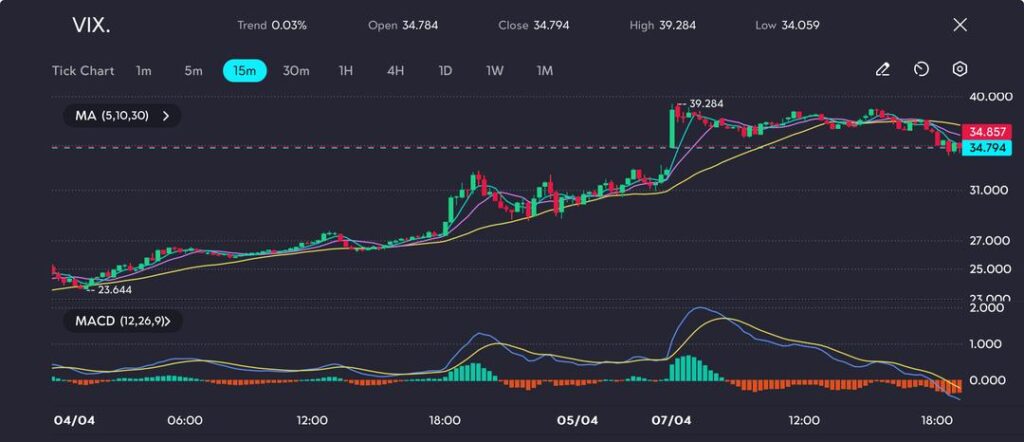
Key Points
- VIX jumps to 39.284, signalling extreme volatility as S&P 500 enters bear market and futures dive 4%.
- Hang Seng falls 13% in a single session—the worst one-day loss since 1997—while Taiwan stocks crash nearly 10%.
Global markets are convulsing under the weight of a spiralling trade war, evaporating investor confidence, and a sudden vacuum of central bank support. Equities across the globe continued to plummet, with the S&P 500 futures (SP500) down 4% at one point on Monday, adding to a brutal two-day decline that has already erased over $5 trillion in market value.
The benchmark VIX index climbed to 39.284 before settling around 34.794, pushing into crisis-level volatility not seen since August. On the 15-minute chart, the volatility index has broken clear of any near-term resistance, rising from a low of 23.644 in just 48 hours—an abrupt signal that traders are fleeing risk across all asset classes.
No Pivot from the White House or the Fed
President Trump has doubled down on his stance, declaring, “Sometimes you have to take medicine to fix something,” after golfing over the weekend. This cold prescription came after markets suffered their worst week since March 2020, but the White House shows no intention of reversing the heavy-handed tariff regime that is now inflicting global economic harm.
Trump’s tariff agenda has triggered 34% retaliatory duties from China and prompted EU leaders to fast-track countermeasures on up to $28 billion in U.S. goods—from dental floss to industrial machinery.
Meanwhile, Federal Reserve Chair Jerome Powell remained noncommittal. While acknowledging rising anxiety in the business community, Powell highlighted the inflationary risks of tariffs and signalled no urgency to cut interest rates, despite markets pricing in up to five cuts for the year. This has left traders questioning whether either branch of US leadership will act to stop the bleeding.
U.S. Tech and Banks Enter the Crosshairs
Market participants hoping that megacap tech stocks would provide shelter from the storm have been disabused of that notion. The “Magnificent Seven” tech leaders—once the darlings of global portfolios—have now entered a bear market of their own, shedding more than 25% from their December highs.
This comes amid warnings from economists such as Ricardo Hausmann, who point out that while the U.S. runs a massive goods deficit, it also enjoys a $1 trillion services surplus. This includes digital platforms, finance, and intellectual property—precisely the sectors now most vulnerable to non-tariff retaliation. French officials, for instance, are floating investment freezes and regulatory actions against U.S. firms, going far beyond traditional tariff tools.
The EU’s new Anti-Coercion Instrument gives it teeth to restrict U.S. access to public procurement, financial services, and IP protections—areas dominated by Big Tech and large American banks.
Global Selloff Deepens
Asian equity markets suffered historic losses on Monday, as panic over escalating trade tensions sent traders fleeing. Taiwan’s stock market crashed 10%, marking its largest single-day decline on record, while Hong Kong’s Hang Seng Index plunged 13%, a collapse not seen since the 1997 Asian Financial Crisis. The carnage extended to tech stocks, with the Hang Seng Tech Index falling 17%, its worst single-day performance in history, despite efforts by China’s Central Huijin sovereign wealth fund to stabilise the market through direct intervention.
These dramatic declines reflect deepening fears of a global economic slowdown, particularly in export-heavy regions vulnerable to U.S.-led tariff disruptions. The selloff underscores how exposed Asia’s tech and manufacturing sectors are to geopolitical risk and investor sentiment, with recovery unlikely without clear diplomatic or monetary policy shifts.
Meanwhile, Treasury yields briefly rose, then retraced as demand returned, with the 10-year yield falling to 3.953%. The US dollar strengthened, especially against the Chinese yuan, as capital fled toward perceived safety.
Oil markets plunged as well. WTI crude dropped to a four-year low, while even traditional safe havens like gold and Bitcoin fell, suggesting widespread liquidation to cover losses.
Technical Analysis
The VIX chart reflects a significant surge in volatility, jumping from 23.644 to a peak of 39.284 within a few sessions—a strong indicator of rising market fear or uncertainty. This spike aligns with the recent drop seen in the SP500, suggesting a sharp risk-off sentiment across markets.
Picture: Elevated VIX signals heightened caution across the board, as seen on the VT Markets app
After the sharp run-up, volatility consolidated and began tapering off slightly, with the MACD crossing into bearish territory and the price slipping below the short-term moving averages. However, it’s still hovering at elevated levels, signaling lingering caution among traders.
Cautious Forecast
Traders should expect choppy markets and sustained volatility in the near term. The VIX remains elevated, the S&P 500 is in confirmed bear market territory, and macroeconomic data this week—especially Thursday’s US inflation print—will likely add more fuel to already burning volatility.
Unless the White House alters course or the Federal Reserve signals clear monetary support, sentiment may deteriorate further. Markets are likely to remain under pressure as hedge funds de-risk, retail traders panic-sell, and corporate earnings season opens with a likely barrage of downward revisions and margin pressure.










